Xin Xin
School of Computer Science, Beijing Institute of Technology
The 1st EReL@MIR Workshop on Efficient Representation Learning for Multimodal Information Retrieval
Apr 21, 2025Abstract:Multimodal representation learning has garnered significant attention in the AI community, largely due to the success of large pre-trained multimodal foundation models like LLaMA, GPT, Mistral, and CLIP. These models have achieved remarkable performance across various tasks of multimodal information retrieval (MIR), including web search, cross-modal retrieval, and recommender systems, etc. However, due to their enormous parameter sizes, significant efficiency challenges emerge across training, deployment, and inference stages when adapting these models' representation for IR tasks. These challenges present substantial obstacles to the practical adaptation of foundation models for representation learning in information retrieval tasks. To address these pressing issues, we propose organizing the first EReL@MIR workshop at the Web Conference 2025, inviting participants to explore novel solutions, emerging problems, challenges, efficiency evaluation metrics and benchmarks. This workshop aims to provide a platform for both academic and industry researchers to engage in discussions, share insights, and foster collaboration toward achieving efficient and effective representation learning for multimodal information retrieval in the era of large foundation models.
Improving Sequential Recommenders through Counterfactual Augmentation of System Exposure
Apr 18, 2025Abstract:In sequential recommendation (SR), system exposure refers to items that are exposed to the user. Typically, only a few of the exposed items would be interacted with by the user. Although SR has achieved great success in predicting future user interests, existing SR methods still fail to fully exploit system exposure data. Most methods only model items that have been interacted with, while the large volume of exposed but non-interacted items is overlooked. Even methods that consider the whole system exposure typically train the recommender using only the logged historical system exposure, without exploring unseen user interests. In this paper, we propose counterfactual augmentation over system exposure for sequential recommendation (CaseRec). To better model historical system exposure, CaseRec introduces reinforcement learning to account for different exposure rewards. CaseRec uses a decision transformer-based sequential model to take an exposure sequence as input and assigns different rewards according to the user feedback. To further explore unseen user interests, CaseRec proposes to perform counterfactual augmentation, where exposed original items are replaced with counterfactual items. Then, a transformer-based user simulator is proposed to predict the user feedback reward for the augmented items. Augmentation, together with the user simulator, constructs counterfactual exposure sequences to uncover new user interests. Finally, CaseRec jointly uses the logged exposure sequences with the counterfactual exposure sequences to train a decision transformer-based sequential model for generating recommendation. Experiments on three real-world benchmarks show the effectiveness of CaseRec. Our code is available at https://github.com/ZiqiZhao1/CaseRec.
Constrained Auto-Regressive Decoding Constrains Generative Retrieval
Apr 14, 2025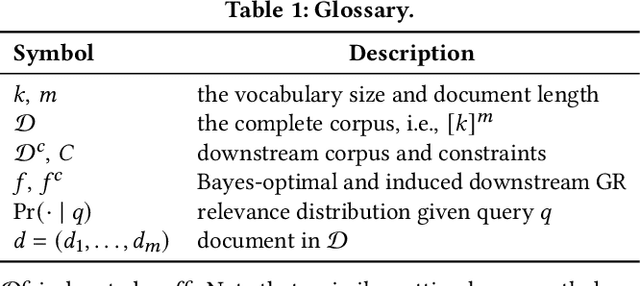
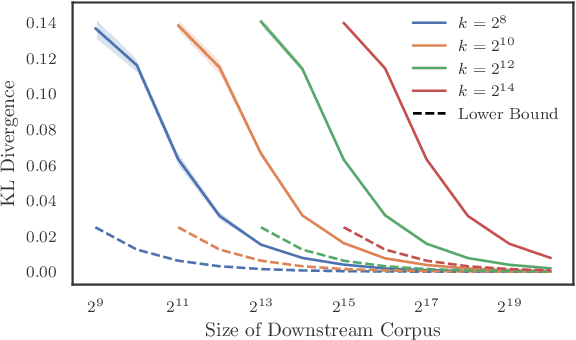
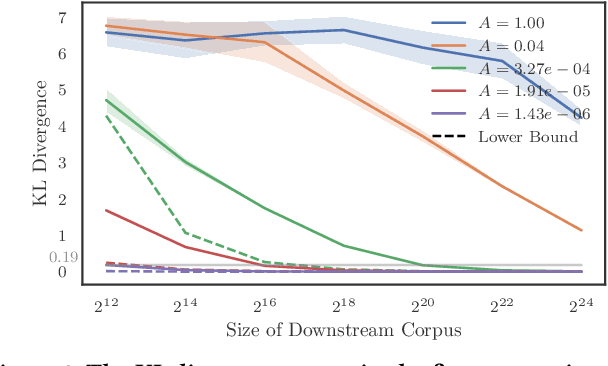
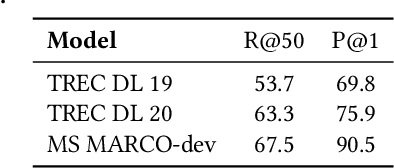
Abstract:Generative retrieval seeks to replace traditional search index data structures with a single large-scale neural network, offering the potential for improved efficiency and seamless integration with generative large language models. As an end-to-end paradigm, generative retrieval adopts a learned differentiable search index to conduct retrieval by directly generating document identifiers through corpus-specific constrained decoding. The generalization capabilities of generative retrieval on out-of-distribution corpora have gathered significant attention. In this paper, we examine the inherent limitations of constrained auto-regressive generation from two essential perspectives: constraints and beam search. We begin with the Bayes-optimal setting where the generative retrieval model exactly captures the underlying relevance distribution of all possible documents. Then we apply the model to specific corpora by simply adding corpus-specific constraints. Our main findings are two-fold: (i) For the effect of constraints, we derive a lower bound of the error, in terms of the KL divergence between the ground-truth and the model-predicted step-wise marginal distributions. (ii) For the beam search algorithm used during generation, we reveal that the usage of marginal distributions may not be an ideal approach. This paper aims to improve our theoretical understanding of the generalization capabilities of the auto-regressive decoding retrieval paradigm, laying a foundation for its limitations and inspiring future advancements toward more robust and generalizable generative retrieval.
LLMPopcorn: An Empirical Study of LLMs as Assistants for Popular Micro-video Generation
Feb 19, 2025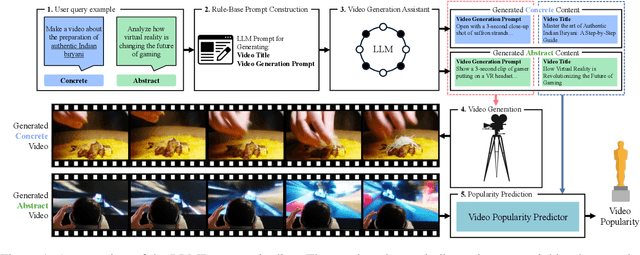
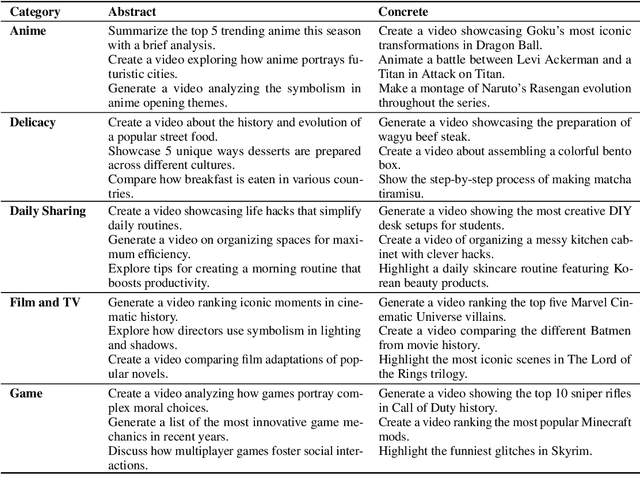
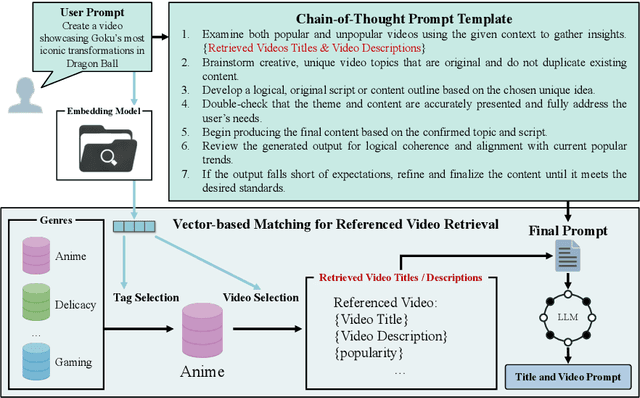
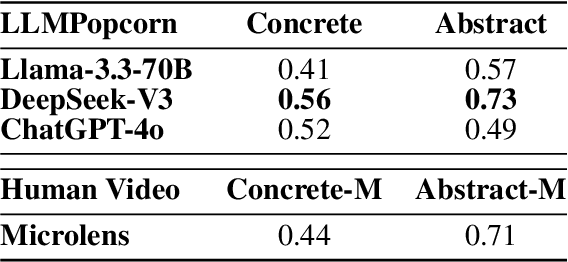
Abstract:Popular Micro-videos, dominant on platforms like TikTok and YouTube, hold significant commercial value. The rise of high-quality AI-generated content has spurred interest in AI-driven micro-video creation. However, despite the advanced capabilities of large language models (LLMs) like ChatGPT and DeepSeek in text generation and reasoning, their potential to assist the creation of popular micro-videos remains largely unexplored. In this paper, we conduct an empirical study on LLM-assisted popular micro-video generation (LLMPopcorn). Specifically, we investigate the following research questions: (i) How can LLMs be effectively utilized to assist popular micro-video generation? (ii) To what extent can prompt-based enhancements optimize the LLM-generated content for higher popularity? (iii) How well do various LLMs and video generators perform in the popular micro-video generation task? By exploring these questions, we show that advanced LLMs like DeepSeek-V3 enable micro-video generation to achieve popularity comparable to human-created content. Prompt enhancements further boost popularity, and benchmarking highlights DeepSeek-V3 and DeepSeek-R1 among LLMs, while LTX-Video and HunyuanVideo lead in video generation. This pioneering work advances AI-assisted micro-video creation, uncovering new research opportunities. We will release the code and datasets to support future studies.
Reverse Region-to-Entity Annotation for Pixel-Level Visual Entity Linking
Dec 18, 2024



Abstract:Visual Entity Linking (VEL) is a crucial task for achieving fine-grained visual understanding, matching objects within images (visual mentions) to entities in a knowledge base. Previous VEL tasks rely on textual inputs, but writing queries for complex scenes can be challenging. Visual inputs like clicks or bounding boxes offer a more convenient alternative. Therefore, we propose a new task, Pixel-Level Visual Entity Linking (PL-VEL), which uses pixel masks from visual inputs to refer to objects, supplementing reference methods for VEL. To facilitate research on this task, we have constructed the MaskOVEN-Wiki dataset through an entirely automatic reverse region-entity annotation framework. This dataset contains over 5 million annotations aligning pixel-level regions with entity-level labels, which will advance visual understanding towards fine-grained. Moreover, as pixel masks correspond to semantic regions in an image, we enhance previous patch-interacted attention with region-interacted attention by a visual semantic tokenization approach. Manual evaluation results indicate that the reverse annotation framework achieved a 94.8% annotation success rate. Experimental results show that models trained on this dataset improved accuracy by 18 points compared to zero-shot models. Additionally, the semantic tokenization method achieved a 5-point accuracy improvement over the trained baseline.
Topology-Aware Popularity Debiasing via Simplicial Complexes
Nov 21, 2024Abstract:Recommender systems (RS) play a critical role in delivering personalized content across various online platforms, leveraging collaborative filtering (CF) as a key technique to generate recommendations based on users' historical interaction data. Recent advancements in CF have been driven by the adoption of Graph Neural Networks (GNNs), which model user-item interactions as bipartite graphs, enabling the capture of high-order collaborative signals. Despite their success, GNN-based methods face significant challenges due to the inherent popularity bias in the user-item interaction graph's topology, leading to skewed recommendations that favor popular items over less-known ones. To address this challenge, we propose a novel topology-aware popularity debiasing framework, Test-time Simplicial Propagation (TSP), which incorporates simplicial complexes (SCs) to enhance the expressiveness of GNNs. Unlike traditional methods that focus on pairwise relationships, our approach captures multi-order relationships through SCs, providing a more comprehensive representation of user-item interactions. By enriching the neighborhoods of tail items and leveraging SCs for feature smoothing, TSP enables the propagation of multi-order collaborative signals and effectively mitigates biased propagation. Our TSP module is designed as a plug-and-play solution, allowing for seamless integration into pre-trained GNN-based models without the need for fine-tuning additional parameters. Extensive experiments on five real-world datasets demonstrate the superior performance of our method, particularly in long-tail recommendation tasks. Visualization results further confirm that TSP produces more uniform distributions of item representations, leading to fairer and more accurate recommendations.
Efficient and Effective Adaptation of Multimodal Foundation Models in Sequential Recommendation
Nov 05, 2024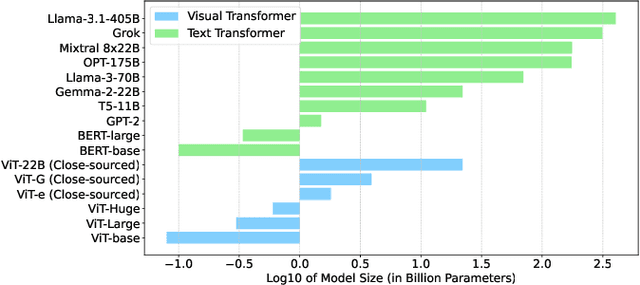
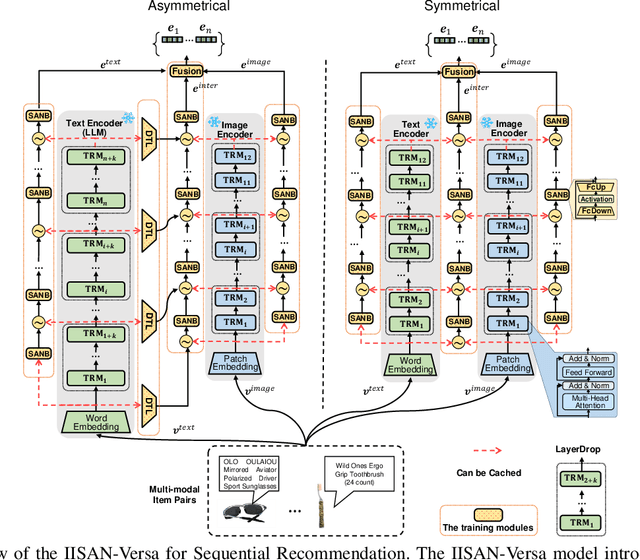
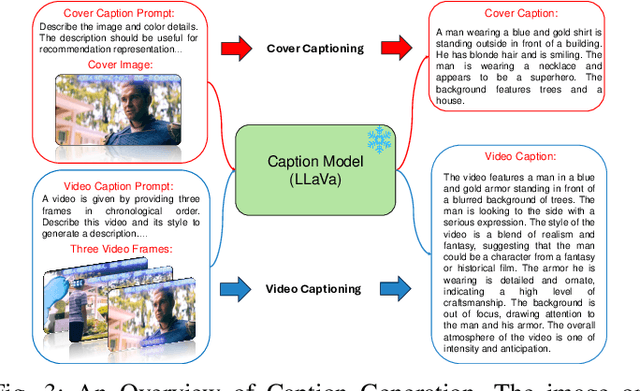
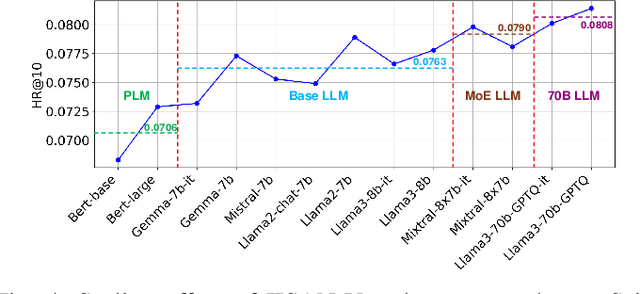
Abstract:Multimodal foundation models (MFMs) have revolutionized sequential recommender systems through advanced representation learning. While Parameter-efficient Fine-tuning (PEFT) is commonly used to adapt these models, studies often prioritize parameter efficiency, neglecting GPU memory and training speed. To address this, we introduced the IISAN framework, significantly enhancing efficiency. However, IISAN was limited to symmetrical MFMs and identical text and image encoders, preventing the use of state-of-the-art Large Language Models. To overcome this, we developed IISAN-Versa, a versatile plug-and-play architecture compatible with both symmetrical and asymmetrical MFMs. IISAN-Versa employs a Decoupled PEFT structure and utilizes both intra- and inter-modal adaptation. It effectively handles asymmetry through a simple yet effective combination of group layer-dropping and dimension transformation alignment. Our research demonstrates that IISAN-Versa effectively adapts large text encoders, and we further identify a scaling effect where larger encoders generally perform better. IISAN-Versa also demonstrates strong versatility in our defined multimodal scenarios, which include raw titles and captions generated from images and videos. Additionally, IISAN-Versa achieved state-of-the-art performance on the Microlens public benchmark. We will release our code and datasets to support future research.
PSL: Rethinking and Improving Softmax Loss from Pairwise Perspective for Recommendation
Oct 31, 2024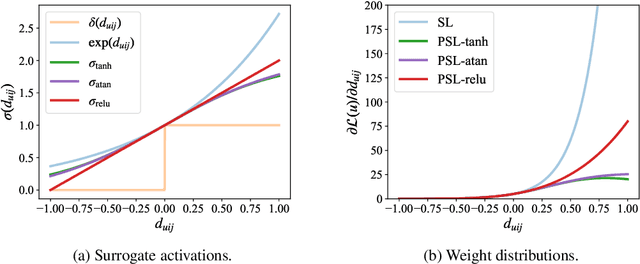
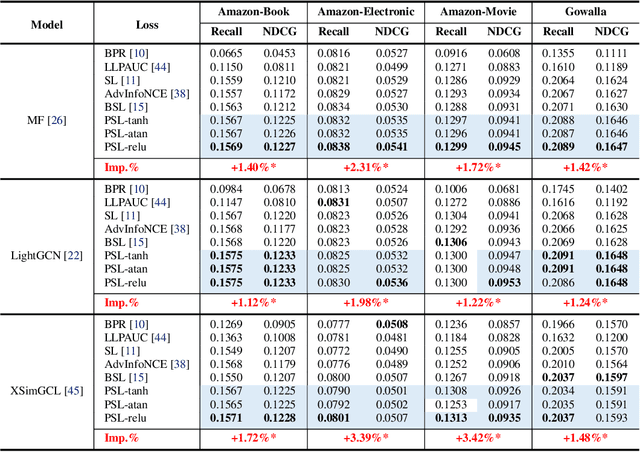
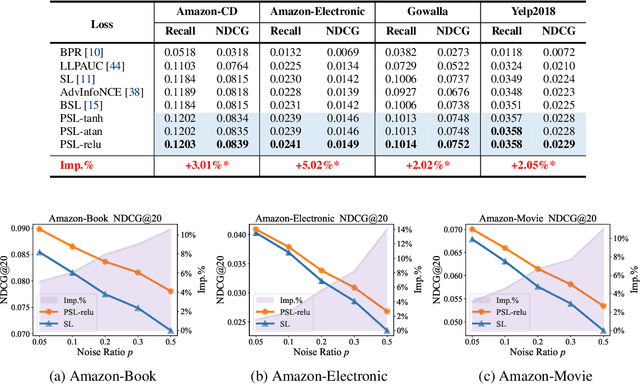

Abstract:Softmax Loss (SL) is widely applied in recommender systems (RS) and has demonstrated effectiveness. This work analyzes SL from a pairwise perspective, revealing two significant limitations: 1) the relationship between SL and conventional ranking metrics like DCG is not sufficiently tight; 2) SL is highly sensitive to false negative instances. Our analysis indicates that these limitations are primarily due to the use of the exponential function. To address these issues, this work extends SL to a new family of loss functions, termed Pairwise Softmax Loss (PSL), which replaces the exponential function in SL with other appropriate activation functions. While the revision is minimal, we highlight three merits of PSL: 1) it serves as a tighter surrogate for DCG with suitable activation functions; 2) it better balances data contributions; and 3) it acts as a specific BPR loss enhanced by Distributionally Robust Optimization (DRO). We further validate the effectiveness and robustness of PSL through empirical experiments. The code is available at https://github.com/Tiny-Snow/IR-Benchmark.
R^3AG: First Workshop on Refined and Reliable Retrieval Augmented Generation
Oct 27, 2024Abstract:Retrieval-augmented generation (RAG) has gained wide attention as the key component to improve generative models with external knowledge augmentation from information retrieval. It has shown great prominence in enhancing the functionality and performance of large language model (LLM)-based applications. However, with the comprehensive application of RAG, more and more problems and limitations have been identified, thus urgently requiring further fundamental exploration to improve current RAG frameworks. This workshop aims to explore in depth how to conduct refined and reliable RAG for downstream AI tasks. To this end, we propose to organize the first R3AG workshop at SIGIR-AP 2024 to call for participants to re-examine and formulate the basic principles and practical implementation of refined and reliable RAG. The workshop serves as a platform for both academia and industry researchers to conduct discussions, share insights, and foster research to build the next generation of RAG systems. Participants will engage in discussions and presentations focusing on fundamental challenges, cutting-edge research, and potential pathways to improve RAG. At the end of the workshop, we aim to have a clearer understanding of how to improve the reliability and applicability of RAG with more robust information retrieval and language generation.
Beyond Local Views: Global State Inference with Diffusion Models for Cooperative Multi-Agent Reinforcement Learning
Aug 18, 2024



Abstract:In partially observable multi-agent systems, agents typically only have access to local observations. This severely hinders their ability to make precise decisions, particularly during decentralized execution. To alleviate this problem and inspired by image outpainting, we propose State Inference with Diffusion Models (SIDIFF), which uses diffusion models to reconstruct the original global state based solely on local observations. SIDIFF consists of a state generator and a state extractor, which allow agents to choose suitable actions by considering both the reconstructed global state and local observations. In addition, SIDIFF can be effortlessly incorporated into current multi-agent reinforcement learning algorithms to improve their performance. Finally, we evaluated SIDIFF on different experimental platforms, including Multi-Agent Battle City (MABC), a novel and flexible multi-agent reinforcement learning environment we developed. SIDIFF achieved desirable results and outperformed other popular algorithms.
 Add to Chrome
Add to Chrome Add to Firefox
Add to Firefox Add to Edge
Add to Edge